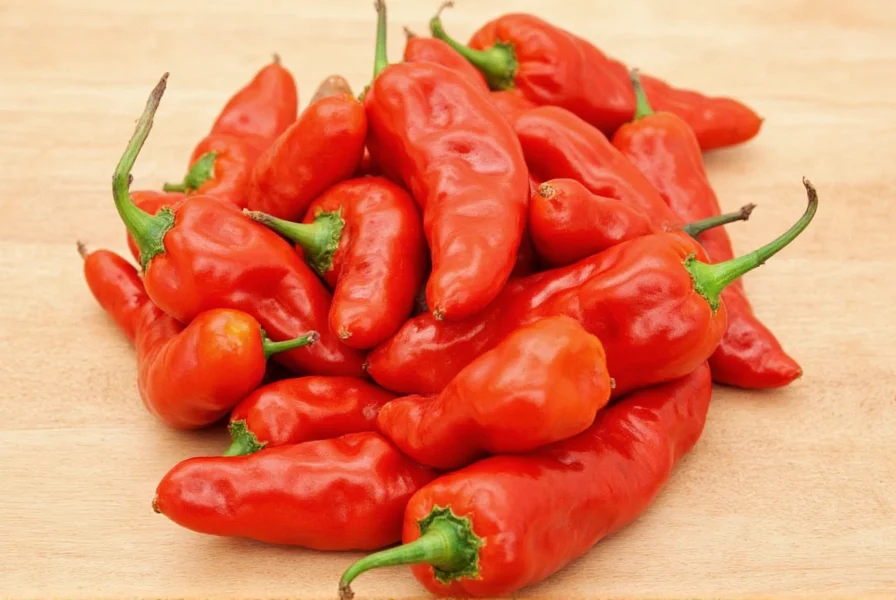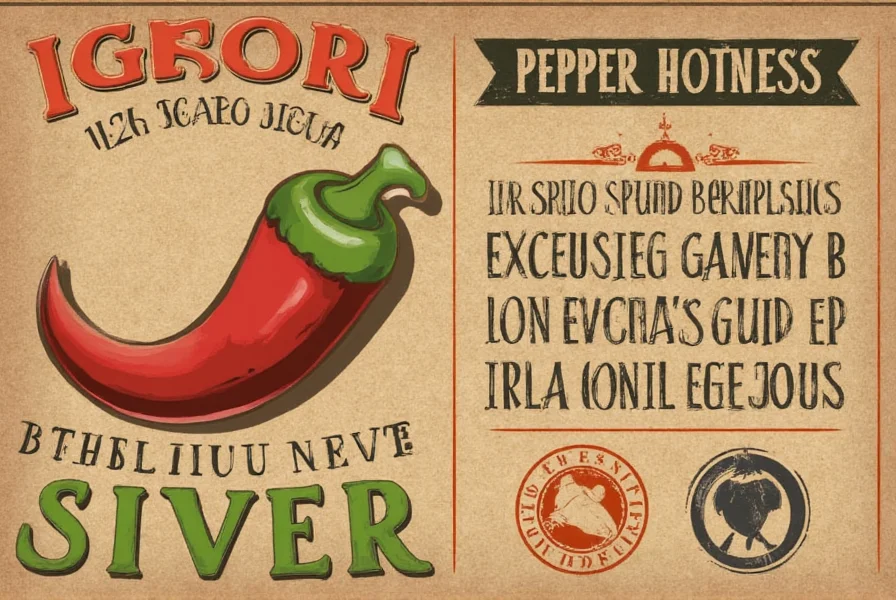Peppers are hot because of a compound called capsaicin. This natural chemical binds to pain receptors in your mouth and skin, tricking your body into feeling a burning sensation — even though no actual heat is involved. In this article, we'll explain the science behind spicy heat, how it's measured, and practical tips to manage the burn when eating hot peppers.
Table of Contents
- The Science of Spice: Capsaicin and Beyond
- How Is Pepper Heat Measured?
- Top 5 Hottest Peppers in the World
- Why Are Some Peppers Hot While Others Aren't?
- Tips to Handle the Heat Like a Pro
- Buying Guide: How to Choose the Right Pepper for Your Taste
- Frequently Asked Questions
- Conclusion
The Science of Spice: Capsaicin and Beyond

The star player behind the heat in hot peppers is a compound called capsaicin. Found primarily in the placenta (the white part inside the pepper), capsaicin binds to pain receptors in your mouth and skin, tricking them into thinking they're being burned — even though no actual heat is involved.
Capsaicin belongs to a family of compounds known as capsaicinoids, with several other members like dihydrocapsaicin contributing to the overall sensation of spiciness. The concentration of these compounds determines just how hot a particular pepper will be.
Interestingly, birds are immune to the effects of capsaicin, which is why wild peppers often rely on them for seed dispersal. Mammals, including humans, however, feel every bit of that burning sensation.
How Is Pepper Heat Measured?
Heat in peppers is measured using the Scoville Scale, developed by pharmacist Wilbur Scoville in 1912. Originally, the test involved diluting a pepper extract until a panel of tasters could no longer detect the heat. The number of dilutions required gave the Scoville Heat Units (SHU).
Today, high-performance liquid chromatography (HPLC) is used for more accurate readings, but the SHU remains the standard metric.
| Pepper Type | Scoville Heat Units (SHU) |
|---|---|
| Bell Pepper | 0 |
| Jalapeño | 2,500–8,000 |
| Habanero | 100,000–350,000 |
| Ghost Pepper (Bhut Jolokia) | ~1,000,000 |
| Carolina Reaper | ~2,200,000 |
Top 5 Hottest Peppers in the World
If you're looking to test your tolerance or simply curious about the extreme end of the spice spectrum, here are the current top five hottest peppers ranked by average Scoville units:
- Carolina Reaper – 1.4 to 2.2 million SHU
- Trinidad Moruga Scorpion – Up to 2 million SHU
- Naga Viper – Around 1.4 million SHU
- Bhut Jolokia (Ghost Pepper) – Up to 1 million SHU
- 7 Pot Douglah – Known for its chocolatey undertone and extreme heat (~900,000 SHU)
These peppers aren't just hot; they can cause physical reactions ranging from sweating and tearing up to temporary numbness. Always use gloves when handling them, and never touch your eyes after contact!
Why Are Some Peppers Hot While Others Aren't?

You might wonder why bell peppers are mild while jalapeños pack a punch. It all comes down to genetics and environmental factors.
- Genetics: The presence of specific genes determines whether a plant produces capsaicinoids. Bell peppers lack these genes entirely.
- Climate: Peppers grown in hotter climates tend to be spicier due to increased capsaicin production.
- Stress Factors: Plants under stress (like drought or poor soil) may increase their capsaicin content as a defense mechanism.
- Seed Inheritance: Offspring of spicy peppers can vary in heat depending on pollination and genetic drift.
So, if you're growing your own peppers, remember that a little stress can go a long way toward boosting flavor — and heat!
Tips to Handle the Heat Like a Pro
Love the heat but hate the burn? Here are some tried-and-true ways to tame the fire without compromising flavor:
- Milk it! Dairy products, especially whole milk, contain casein, which helps break down capsaicin.
- Sugar and starch help too – A spoonful of sugar or a bite of bread can neutralize some of the heat.
- Don't drink water – Water spreads the oil-based capsaicin around your mouth instead of washing it away.
- Rinse with alcohol – Alcohol helps dissolve the capsaicin oils (think mouthwash or a sip of beer).
- Wear gloves when chopping super-spicy peppers to avoid skin irritation later.
And don't forget: Build up your tolerance slowly. Regular exposure to capsaicin can actually desensitize your receptors over time — meaning you can handle more heat without breaking a sweat!
Buying Guide: How to Choose the Right Pepper for Your Taste
Choosing the right pepper depends on your personal heat threshold, intended use, and flavor preferences. Here's a breakdown of popular options and who they're best suited for:
| Pepper | Heat Level (SHU) | Flavor Profile | Best For | Ideal Use |
|---|---|---|---|---|
| Bell Pepper | 0 | Sweet, crunchy, vegetal | Kids, spice-sensitive adults | Salads, stuffed peppers, stir-fries |
| Jalapeño | 2,500–8,000 | Grassy, fresh, mildly spicy | Casual spice lovers | Tacos, nachos, salsas |
| Hatch Green Chile | 1,000–8,000 | Smoky, earthy, slightly sweet | Southwestern cuisine fans | Enchiladas, chiles rellenos, sauces |
| Habanero | 100,000–350,000 | Fruity, floral, intensely spicy | Experienced spice lovers | Hot sauces, marinades, tropical-inspired dishes |
| Carolina Reaper | ~2,200,000 | Intense heat with subtle sweetness | Extreme heat seekers | Pepper eating contests, DIY hot sauces |
When buying fresh peppers, look for firm, vibrant colors with smooth skin. Avoid those that are wrinkled, soft, or discolored. Dried peppers should be pliable and not brittle. If you're using them for sauces or powders, opt for dried varieties as they have a more concentrated flavor.
Frequently Asked Questions
What compound makes peppers hot?
The compound responsible for the heat in peppers is called capsaicin. It's primarily found in the placenta (the white part inside the pepper) and binds to pain receptors in your mouth and skin, creating the burning sensation we associate with spicy food.
Why do peppers produce capsaicin?
Peppers produce capsaicin as a defense mechanism. It deters mammals from eating the peppers (who would crush the seeds while chewing), while birds—which are immune to capsaicin—can eat the peppers and disperse the seeds intact through their droppings.
Why do some people enjoy spicy food if it causes pain?
When capsaicin triggers pain receptors, your body releases endorphins—natural painkillers that create a feeling of pleasure. Many people enjoy this "endorphin rush." Additionally, regular exposure to capsaicin can desensitize receptors over time, allowing spice lovers to handle increasingly hotter foods.
Does cooking peppers make them hotter?
Not exactly. Cooking can actually break down some capsaicin, potentially reducing heat. However, cooking releases capsaicin into the surrounding food, which may make the overall dish taste spicier as the heat distributes more evenly. Frying or roasting can also enhance the flavor compounds in peppers.
Why do some peppers of the same variety have different heat levels?
Heat levels can vary due to growing conditions like climate, soil quality, water availability, and even the specific part of the plant the pepper grew on. Stress factors can cause plants to produce more capsaicin as a defense mechanism, making some peppers hotter than others of the same variety.
How can I reduce the heat of a pepper?
To reduce heat, remove the placenta (white membrane inside) and seeds where most capsaicin is concentrated. Soaking cut peppers in vinegar or salt water can also draw out some capsaicin. For cooked dishes, adding dairy, sugar, or starch can help neutralize the heat.
Are hot peppers bad for you?
Hot peppers are generally safe and even beneficial for most people. Capsaicin has been linked to various health benefits including pain relief, improved metabolism, and heart health. However, extremely spicy peppers can cause temporary discomfort, and people with certain digestive conditions may need to limit their intake.
Why doesn't water help with spicy food burn?
Water doesn't help because capsaicin is oil-soluble, not water-soluble. Drinking water just spreads the oil around your mouth. Dairy products (which contain casein), fats, or sugars are more effective at neutralizing the burn because they can bind with and dissolve the capsaicin oils.
Conclusion
From the complex chemistry of capsaicin to the wide range of flavors and heat levels, hot peppers offer more than just a spicy kick — they add depth, excitement, and a bit of adventure to any dish. Whether you're dipping your toe into mild territory or diving headfirst into the world of ultra-hot peppers, understanding what makes hot peppers hot can enhance your culinary experience and even improve your spice-handling skills.
So next time you reach for that jalapeño or dare yourself to try a Carolina Reaper, remember: the burn is real, but so is the reward. Embrace the fire, enjoy the flavor, and most importantly — stay safe out there!










 浙公网安备
33010002000092号
浙公网安备
33010002000092号 浙B2-20120091-4
浙B2-20120091-4